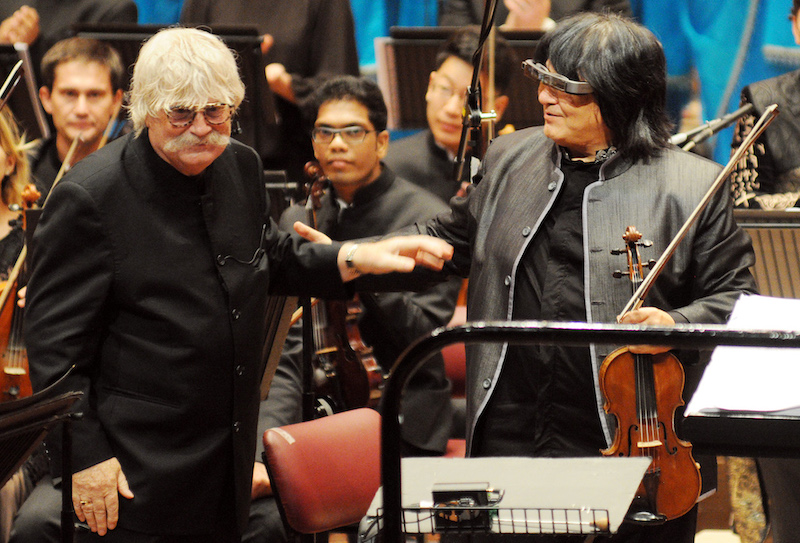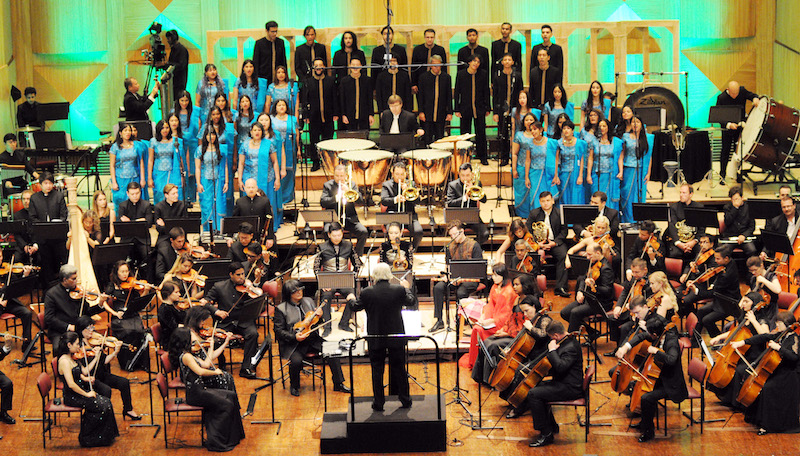Music That Moves

The Symphony Orchestra of India and its founding music director Marat Bisengaliev have worked closely with Welsh composer, multi-instrumentalist and conductor Sir Karl Jenkins over the years. We speak to Bisengaliev to learn about his long-standing association with Jenkins ahead of the upcoming SOI Spring 2023 Season that includes the India premiere of Jenkins’s Requiem.
Back in 2017, Karl Jenkins’s fantastical Alem the Universe was presented across two evenings in September at the Jamshed Bhabha Theatre. Originally commissioned by violin virtuoso and Symphony Orchestra of India (SOI) co-founder Marat Bisengaliev for the Expo 2017 in Astana, Kazakhstan, the work for choir and orchestra enjoyed a spectacular international premiere presented by the SOI and Living Voices choir under the baton of Jenkins himself with soloists including Bisengaliev. The long-standing association between Bisengaliev, the SOI and the celebrated Welsh composer and conductor was conspicuous at these performances at the NCPA. The ease with which Jenkins straddles musical genres—from Western classical to folk and jazz—was palpable too.
Aside from his ability to write music that draws from various cultures, Jenkins’s music has enjoyed commercial success in the field of advertising. His compositions for the television commercials of De Beers and British Airways are hard to forget, as is the central theme song of the Delta Airlines commercial which Jenkins effortlessly developed into what would become his most celebrated choral work Adiemus. Written in 1994 and performed by the London Philharmonic Orchestra, it was released as the title track on the 1995 album Adiemus: Songs of Sanctuary. With classical music as its foundation, the composition is tinged with African and Celtic melodies.
Jenkins isn’t one to break barriers or be novel for the sake of it. “I don’t aim to please people. Even if I did, I could never guess what they like. I’m true to myself and the style that I write, and it does happen to communicate with people—which is my greatest aim, really,” said Jenkins in an interview with ON Stage in 2017. It is hardly surprising that the composer has enjoyed the status of having been in the UK Classical charts for 18 years and is widely recognised as one of the most performed living composers, as per a global survey in 2011.
A remarkable bond
Bisengaliev and Jenkins have enjoyed a longstanding association that goes back to a period prior to 2005. “I had heard a lot of Jenkins’s music on television, but I didn’t know who had made it at the time. I asked Chris Craker, my producer at Sony BMG, who told me that it was Jenkins and that he knew him very well. I asked to be introduced to him. At the time, I was with the West Kazakhstan Philharmonic Orchestra through which Khushroo got to know me in London,” says Bisengaliev recalling Chairman Mr Khushroo N. Suntook’s visit to the U.K. when he heard the violin virtuoso and the orchestra for the first time. He invited them to India and this eventually led to the creation of the SOI.

Back in London, one thing led to another and Bisengaliev found himself at Jenkins’s personal studio Mustache in the Soho district armed with a recording of Jenkins’s own Palladio. Bisengaliev had recorded it with his orchestra in the Kazakh city of Uralsk shortly before the meeting. “After the first meeting, he asked if we were available to do a recording of a composition he had written at London’s Angel Studio. I managed to get the support from Air Astana in Kazakhstan and eventually brought my orchestra to London,” says Bisengaliev, who travelled to Wales and London to be closely involved in the orchestral parts prior to the recording.
The recording in question turned out to be Jenkins’s Requiem that he had written in 2004. It would go on to become one of his most highly acclaimed albums. The premiere took place at London’s Southwark Cathedral in 2005 with the West Kazakhstan Philharmonic Orchestra and soloists like Clive Bell on the shakuhachi (Japanese bamboo flute), Catrin Finch on harp, Nicole Tibbels (soprano) and Bisengaliev on violin.
Light in lieu of darkness
A requiem, especially in the Roman Catholic church, is a mass for the repose of the souls of the dead, and many a composer has used this idiom for centuries. Jenkins’s Requiem, dedicated to his late musician father, integrates Japanese haiku with the movements of the Catholic mass for the souls of the dead, and is performed by a choir and orchestra. “In general, I have set the usual Latin movements but in keeping with my trait of drawing from other cultures, I have also set five Japanese haiku ‘death’ poems. Such poems are usually to do with nature, have a single idea, and consist of 17 syllables divided 5-7-5 over three lines,” says Jenkins on the website of his music publisher Boosey & Hawkes.
“One can think of it as a beautiful expression of life and death,” Bisengaliev tells us. “It incorporates the oriental way of thinking about death—that it is not tragic, but can be something that is pure and spiritually eternal. You will notice that his work is different from any other requiem because of the lightness with which it looks at the concept of death. It is treated as something that’s not the end of the cycle in Japanese and Buddhist traditions. His work shows us that death can be looked at as the beginning of a new life, a reincarnation that’s not typically dark.”
Jenkins and the SOI
When the SOI was established in 2006, Jenkins’s works found their way to the NCPA. The Welsh composer’s ‘Cantus Insolitus’ was part of the SOI’s repertoire in its very first season. Many still reminisce about the opening of the Spring 2009 season with the Karl Jenkins Anniversary Concert, where Jenkins first presented his music in a big production with the SOI and Living Voices choir at the NCPA. The programme included Adiemus: Songs of Sanctuary, Palladio, as well as Sarikiz, one of the many violin concertos he has written over the years for Bisengaliev. “Working with the SOI was wonderful and Marat suggested we use the bansuri instead of the quena for a special Indian sound,” Jenkins later said in an interview with ONStage about the 2009 performance.

The following year, in 2010, two of Jenkins’s works were performed at the opening concert of the SOI’s ninth season. Music aficionados, both those inclined to Western classical music and otherwise, were left in awe of the compositions. “Jenkins manages to incorporate the best of all worlds. He doesn’t view music as purely classical and is easily able to use elements of folk music too. He makes us realise that music doesn’t need to be put in a bracket. He writes music that’s truly democratic and loved by the majority,” says Bisengaliev.
A full circle
Next month, at the India premiere of Requiem, Jenkins will bring his holistic vision to the stage. There will be more than one choir as per usual, including the Living Voices choir, the NCPA adults’ choir, The Bangalore Men, Capella Bangalore and Delhi Chamber Choir. Reflecting Jenkins’s signature cross-genre and experimental style, a children’s choir with students from the SOI Music Academy will sing the haiku sections instead of female voices, while a bansuri will replace those parts written for the Japanese bamboo flute. Bisengaliev, who has worked relentlessly to piece together the mosaic of choirs, soloists and the SOI at large, will conduct the Requiem and will appear as solo violinist on Jenkins’s compositions including Air and Energy prior to it. “Jenkins writes music that’s incredibly spiritual and for the heart. Even in Japan where he’s popular, his music is sold under healing music. I do feel that his music heals,” says Bisengaliev. Bringing together over 150 performers, this much-awaited concert will reflect the true manner in which Jenkins’s music serves as a unifying force, both literally and metaphorically.
The SOI Spring 2023 Season will feature two performances of Karl Jenkins’s Requiem.
By Beverly Pereira. This piece was originally published by the National Centre for the Performing Arts, Mumbai, in the January 2023 issue of ON Stage – their monthly arts magazine.





